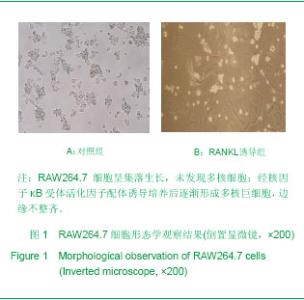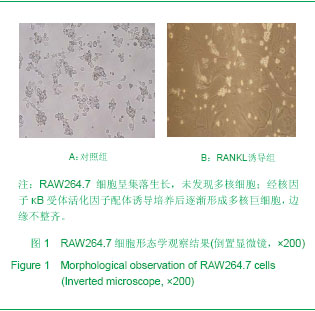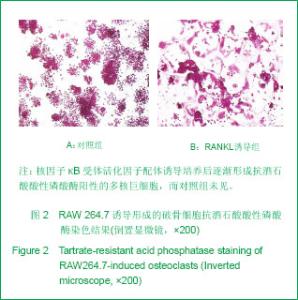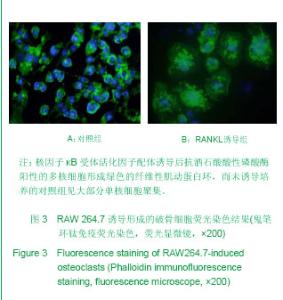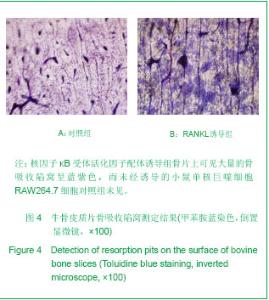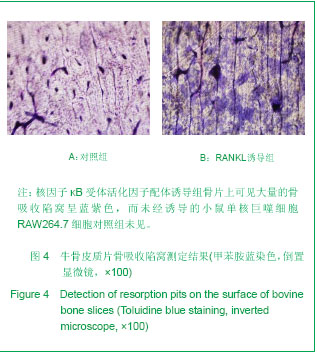Chinese Journal of Tissue Engineering Research ›› 2013, Vol. 17 ›› Issue (24): 4380-4385.doi: 10.3969/j.issn.2095-4344.2013.24.002
Previous Articles Next Articles
Receptor activator of nuclear factor kappa B ligand-induced mature osteoclasts
Chen Guo-xian, Wang Guo-rong, Lin Zong-jin, Li Guo-shan, Guo Chun-xian, Luo Yuan-biao, Zeng Qing-dong, Chen Wei-yi
- Department of Orthopedics, the First Hospital of Putian City, Putian 351100, Fujian Province, China
-
Received:2012-10-13Revised:2012-11-10Online:2013-06-11Published:2013-06-11 -
About author:Chen Guo-xian★, Master, Attending physician, Department of Orthopedics, the First Hospital of Putian City, Putian 351100, Fujian Province, China cosain2000@163.com -
Supported by:Youth Foundation of Fujian Provincial Health Bureau, No. 2011-2-49*; Project of Putian Science and Technology Bureau, No. 2011D02*
CLC Number:
Cite this article
Chen Guo-xian, Wang Guo-rong, Lin Zong-jin, Li Guo-shan, Guo Chun-xian, Luo Yuan-biao, . Receptor activator of nuclear factor kappa B ligand-induced mature osteoclasts[J]. Chinese Journal of Tissue Engineering Research, 2013, 17(24): 4380-4385.
share this article
| [1] Hofbauer LC, Schoppet M. Clinical implications of the steoprotegerin/RANKL/RANK system for bone and vascular diseases.JAMA. 2004;292(4):490-495. http://www.ncbi.nlm.nih.gov/pubmed/?term=15280347 [2] Brad B , Victoria S , Paul JK, et al . Osteoprotegerin , an endogenous antiosteoclast factor for protecting bone in rheumatoid arthritis. Aethritis Rheum. 2002;46(12):3121-3135. http://www.ncbi.nlm.nih.gov/pubmed/?term=12483715[3] Kong YY, Yoshida H, Sarosi I, et al. OPGL is a key regulator of osteoclastgenesis , lymphocyte development and lympya - node organogenesis. Nature. 1999;39(7):315-323. http://www.ncbi.nlm.nih.gov/pubmed/?term=9950424[4] Soysa NS, Alles N. NF-KB functions in osteoclasts. Biochem Biophys Res Commun. 2009;378(1):1-5. http://www.ncbi.nlm.nih.gov/pubmed/?term=18992710[5] Bocyce BF, Xing L. Functions of RANKL/RANK/OPG in bone modeling and remodeling. Arch Biochem Biophys. 2008;473(2):139-146. http://www.ncbi.nlm.nih.gov/pubmed/?term=18395508 [6] Naoko Y, Tohru T, Haruyasu U, et al. Down-regulationg of osteoprotegerin production in bone marrow macrophages by macrophage colony stimulating factor. Cytokine. 2005;31(28):288-297. http://www.ncbi.nlm.nih.gov/pubmed/?term=15996478[7]. Teitelbaum SL.Bone resorption by osteoclasts. Science(Washington DC). 2000; 289(5484) : 1504-1508. http://www.ncbi.nlm.nih.gov/pubmed/?term=10968780[8].. Rodan GA, Martin TJ.Therapeutic approaches to bone diseases. Science. 2000; 289 (5484) : 1508-1514. http://www.ncbi.nlm.nih.gov/pubmed/?term=10968781[9]. Cheng T, Dai M, Fan HX, et al. Zhonghua Shiyan Waike Zazhi. 2007;24(1):113.程涛, 戴闽, 范红先, 等.氧化铝陶瓷和高分子聚乙烯颗粒诱导体内生物学效应和细胞凋亡的研究[J].中华实验外科杂志,2007,24(1):113.http://www.cqvip.com/QK/91364X/200701/23832376.html [10].Battaglino R,Kim D,Fu J,et al.C-myc is required for osteoclast differentiation.J Bone Miner Res. 2002;17(5):763-773. http://www.ncbi.nlm.nih.gov/pubmed/?term=12009006[11].Kieslinger M, Folberth S, Dobreva G, et al. EBF2 regulates osteoblast dependent differentiation of osteoclasts. Dev Cell. 2005; 9(6): 757-767. http://www.ncbi.nlm.nih.gov/pubmed/?term=16326388[12]. Tsubaki M, Kato C, Manno M, et al. Macrophage inflammatory protein-1alpha MIP-1alpha enhances a receptor activator of nuclear factor kappa B ligand RANKL expression in mouse bone marrow stromal cells and osteoblasts through MAPK and PI3K/Akt pathways. Mol Cell Biochem. 2007;304(1-2):53-60. http://www.ncbi.nlm.nih.gov/pubmed/?term=17549607[13].Takeshita S,Kaji K,Kudo A. Identification and characterization of the new osteoclast progenitor with macrophage phenotypes being able to differentiate into mature osteoclasts. Bone Miner Res. 2000;15(8):1477-1488. http://www.ncbi.nlm.nih.gov/pubmed/?term=10934646[14].Monici M,Fusi F,Paglierani M,et al. Modeled gravitational unloading triggers differentiation and apoptosis in preosteoclastic cells. Cell Biochem. 2006;98(1): 65-80. http://www.ncbi.nlm.nih.gov/pubmed/?term=16365883 [15].Ishizuka S,Kurihara N,Hiruma Y,et al. 1alpha 25-Dihydroxy vitamin D(3)-26,23-lactam analogues function as vitamin D receptor antagonists in human and rodent cells. Steroid Biochem Mol Biol. 2008;110(3-5):269-277. http://www.ncbi.nlm.nih.gov/pubmed/?term=18501591[16].Kobayashi Y,Mizoguchi T,Take I,et al. Prostaglandin E2 enhances osteoclastic differentiation of precursor cells through protein kinase A - dependent phosphorylation of TAK1. Biol Chem. 2005;280(12):1395-1403. http://www.ncbi.nlm.nih.gov/pubmed/?term=15647289 [17].Xiao XH, Liao EY, Dong YY. Nanhua Daxue Xuebao: Yixueban. 2008;36(3):282-285.肖新华,廖二元,董源媛. 小鼠单核细胞RAW264.7的细胞生物学特征[J]. 南华大学学报: 医学版, 2008,36(3):282-285.http://www.cqvip.com/qk/96889A/200803/28165868.html [18].Geng DC,Xu YZ,Yang HL,et al. Cannabinoid receptor-2 selective antagonist negatively regulates receptor activator of nuclear factor kappa B ligand mediated osteoclastogenesis. Chin Med. 2011;124(4):586-590. http://www.ncbi.nlm.nih.gov/pubmed/?term=21362286 [19]. Liu C,Walter TS,Huang P,et al. Structural and functional insights of RANKL-RANK interaction and signaling. J Immunol. 2010;184(12):6910-6919. http://www.ncbi.nlm.nih.gov/pubmed?term=PMID%3A%2020483727 [20] Tsurukai T, Udagawa N, Matsuzaki K. Role of macrophage-colony stimulating factor and osteoclast differentiation factor in osteoclastogenesis. Bone Miner Metab. 2000;12(18):177. http://www.ncbi.nlm.nih.gov/pubmed/?term=10874596[21] Lee SW, Kwak HB, Chung WJ, et al. Participation of protein kinase Cβin osteoclast differentiation and function. Bone. 2003;32 (17):217-227. http://www.ncbi.nlm.nih.gov/pubmed/?term=12667549[22] Udagawa N,Takahashi N,Akatsu T,et al.Origin of osteoclasts:mature monocytes and macrophages are capable of differentiating into osteoclasts under a suitable microenvironment prepared by bone marrow-derived stromal cells.Proc Natl Acad Sci USA,1990,87(18);7260-7264. http://www.ncbi.nlm.nih.gov/pubmed/?term=2169622[23] Lee SE, Chung WJ, Kwak HB, et al. Tumor Necrosis Factor-α Supports the Survival of Osteoclasts through the Activation of Akt and ERK. Biol Chem. 2001;276(52) :49343-49349. http://www.ncbi.nlm.nih.gov/pubmed/?term=11675379http://www.jbc.org/content/276/52/49343.long [24].Takahashi N,Udagawa N,Kobayashi Y,et al. Generation of osteoclasts in vitro and assay of osteoclast activity. Methods Mol Med. 2007;135:285-301. http://www.ncbi.nlm.nih.gov/pubmed/?term=17951666[25].He X,Andersson G,Lindgren U,et al. Resveratrol prevents RANKL-induced osteoclast differentiation of murine osteoclast progenitor RAW 264.7 cells through inhibition of ROS production. Biochem Biophys Res Commun. 2010;401(3):356-362. http://www.ncbi.nlm.nih.gov/pubmed/?term=20851107 [26].Hu L,Lind T,Sundqvist A,et al. Retinoic acid increases proliferation of human osteoclast progenitors and inhibits RANKL-stimulated osteoclast differentiation by suppressing RANK. PLoS One. 2010;5(10):13305. http://www.ncbi.nlm.nih.gov/pubmed/?term=20949013[27].Boyle WJ, Simonet WS, Lacey DL.Osteoclast differentiation and activation. Nature. 2003; 423(6937): 337-342. http://www.ncbi.nlm.nih.gov/pubmed/?term=12748652[28].Ferlin A, Pepe A, Facciolli A, et al. Relaxin stimulates osteoclast differentiation and activation. Bone. 2010; 46(2): 504-513. http://www.ncbi.nlm.nih.gov/pubmed/?term=19833242[29] Wu HY, Li J, Tang ZG. Zhongguo Kangfu Yixue Zazhi. 2005;20(4):248-250.吴贺勇,李娟,唐井钢.补肾中药对破骨细胞骨吸收功能的影响[J]. 中国康复医学杂志, 2005,20(4):248-250.http://wzhz.cqvip.com/hzpinglaoshi/qk/90850X/200504/15704606.html [30] Zhan HS, Shi YY, Zhao YF. Zhongyao Xinyao yu Linchuang Yaoli. 2001;12(5):326-328.詹红生, 石印玉, 赵咏芳.含补肾益精方的切卵大鼠血清对破骨细胞骨吸收功能的影响[J]. 中药新药与临床药理,2001, 12(5):326-328.http://d.wanfangdata.com.cn/Periodical_zyxyylcyl200105005.aspx [31] Chen M, Zheng Q, Fang ZH, et al. Zhongguo Jiaoxing Waike Zazhi. 2008;16(4):282-284.陈明,郑琼,方真华,等. 阿伦膦酸钠对骨髓生成破骨细胞骨吸收作用的影响[J].中国矫形外科杂志,2008,16(4):282-284.http://www.cqvip.com/qk/97753A/200804/26610447.html |
| [1] | Hou Jingying, Yu Menglei, Guo Tianzhu, Long Huibao, Wu Hao. Hypoxia preconditioning promotes bone marrow mesenchymal stem cells survival and vascularization through the activation of HIF-1α/MALAT1/VEGFA pathway [J]. Chinese Journal of Tissue Engineering Research, 2021, 25(7): 985-990. |
| [2] | Li Cai, Zhao Ting, Tan Ge, Zheng Yulin, Zhang Ruonan, Wu Yan, Tang Junming. Platelet-derived growth factor-BB promotes proliferation, differentiation and migration of skeletal muscle myoblast [J]. Chinese Journal of Tissue Engineering Research, 2021, 25(7): 1050-1055. |
| [3] | Zheng Xiaolong, He Xiaoming, Gong Shuidi, Pang Fengxiang, Yang Fan, He Wei, Liu Shaojun, Wei Qiushi. Bone turnover characteristics in patients with alcohol-induced osteonecrosis of the femoral head [J]. Chinese Journal of Tissue Engineering Research, 2021, 25(5): 657-661. |
| [4] | Zhou Wu, Wang Binping, Wang Yawen, Cheng Yanan, Huang Xieshan. Transforming growth factor beta combined with bone morphogenetic protein-2 induces the proliferation and differentiation of mouse MC3T3-E1 cells [J]. Chinese Journal of Tissue Engineering Research, 2021, 25(23): 3630-3635. |
| [5] | Yang Caihui, Liu Qicheng, Dong Ming, Wang Lina, Zuo Meina, Lu Ying, Niu Weidong. Serine/threonine protein kinases can promote bone destruction in mouse models of chronic periapical periodontitis [J]. Chinese Journal of Tissue Engineering Research, 2021, 25(23): 3654-3659. |
| [6] | Huo Hua, Cheng Yuting, Zhou Qian, Qi Yuhan, Wu Chao, Shi Qianhui, Yang Tongjing, Liao Jian, Hong Wei. Effects of drug coating on implant surface on the osseointegration [J]. Chinese Journal of Tissue Engineering Research, 2021, 25(22): 3558-3564. |
| [7] | Jiang Shengyuan, Li Dan, Jiang Jianhao, Shang-you Yang, Yang Shuye. Biological response of Co2+ to preosteoblasts during aseptic loosening of the prosthesis [J]. Chinese Journal of Tissue Engineering Research, 2021, 25(21): 3292-3299. |
| [8] | Li Xiaoqun, Xu Kaihang, Ji Fang. Corylin inhibits osteoclastogenesis and attenuates postmenopausal osteoporosis in mice [J]. Chinese Journal of Tissue Engineering Research, 2021, 25(2): 186-190. |
| [9] | Li Congcong, Yao Nan, Huang Dane, Song Min, Peng Sha, Li Anan, Lu Chao, Liu Wengang. Identification and chondrogenic differentiation of human infrapatellar fat pad derived stem cells [J]. Chinese Journal of Tissue Engineering Research, 2021, 25(19): 2976-2981. |
| [10] | Cao Yang, Zhang Junping, Peng Li, Ding Yi, Li Guanghui. Isolation and culture of rabbit aortic endothelial cells and biological characteristics [J]. Chinese Journal of Tissue Engineering Research, 2021, 25(19): 3000-3003. |
| [11] | Xia Guoming, Xu Qiang, Liu Xuqiang, Yu Xiaolong, Dai Min. Application and effect of induced pluripotent stem cells in bone surgery tissue engineering [J]. Chinese Journal of Tissue Engineering Research, 2021, 25(19): 3077-3082. |
| [12] | Fan Siqi, Zeng Ping, Nong Jiao, Liu Jinfu, Qian Xiaofen. Effect of Tongluo Shenggu Capsule-containing serum on osteoclasts and Toll-like receptor 4/nuclear factor-kappa B signaling pathway [J]. Chinese Journal of Tissue Engineering Research, 2021, 25(14): 2155-2160. |
| [13] | Wang Donghui, Wu Xin, Sun Ningning, Zhang Han, Gao Jianfeng. Electroacupuncture intervention on the expression of synaptic plasticity-related proteins in the hippocampi of mice with radiation-induced brain injury [J]. Chinese Journal of Tissue Engineering Research, 2021, 25(14): 2205-2210. |
| [14] | Wu Yukun, Han Jie, Wen Shuaibo. Mechanism of Runx2 gene in fracture healing [J]. Chinese Journal of Tissue Engineering Research, 2021, 25(14): 2274-2279. |
| [15] | Lyu Xiaohong, Gao Yue, Liu Qiang, Pan Shinong. Exercise-induced muscle damage: mechanism, quantitative MRI evaluation and treatment advances [J]. Chinese Journal of Tissue Engineering Research, 2021, 25(14): 2280-2286. |
| Viewed | ||||||
|
Full text |
|
|||||
|
Abstract |
|
|||||
